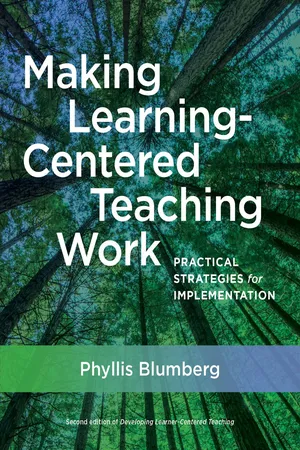
Making Learning-Centered Teaching Work
Practical Strategies for Implementation
- 240 pages
- English
- ePUB (mobile friendly)
- Available on iOS & Android
About this book
This is a substantially expanded and enhanced revision of Phyllis Blumberg's acclaimed and bestselling book, Developing Learner-Centered Teaching: A Practical Guide for Faculty (Jossey-Bass, 2009).
This easy to follow how-to-guide provides faculty with both a thorough introduction to this evidence-based approach to teaching and practical guidance on how to progressively implement it to strengthen the impact of their teaching. It demonstrates how they can integrate learning-centered teaching into their classroom practice without sacrificing content and rigor, and how to positively engage students in the process by demonstrating its impact on their mastery and recall of key concepts and knowledge.
An added outcome, given that learning-centered teaching is correlated with improved student learning, is the resulting assessment data that it provides faculty with the measures to meet the increased demands by accreditors, legislators and society for evidence of improved teaching and learning outcomes. Phyllis Blumberg demonstrates how to use rubrics to not only satisfy outside requirements and accreditation self-studies but, more importantly, for faculty to use for the purposes of self-improvement or their teaching portfolios.
She provides examples of how the rubrics can be used to ascertain whether college-wide strategic plans for teaching excellence are being met, for program review, and to determine the effectiveness of faculty development efforts. The book includes the following features:
- Boxes with easy-to-implement and adaptable examples, covering applications across disciplines and course types
- Worksheets that foster easy implementation of concepts
- Rubrics for self- assessment and peer assessment of learning-centered teaching
- Detailed directions on how to use the rubrics as a teaching assessment tool for individuals, courses, and programs
- List of examples of use classified by discipline and type of course
Phyllis Blumberg offers Making Learning Centered Teaching Course Design Institutes and workshops on this and other teaching and assessment topics. Half day to multiple day modules.
For more information or questions contact [email protected], or IntegrateEd.com
Frequently asked questions
- Essential is ideal for learners and professionals who enjoy exploring a wide range of subjects. Access the Essential Library with 800,000+ trusted titles and best-sellers across business, personal growth, and the humanities. Includes unlimited reading time and Standard Read Aloud voice.
- Complete: Perfect for advanced learners and researchers needing full, unrestricted access. Unlock 1.4M+ books across hundreds of subjects, including academic and specialized titles. The Complete Plan also includes advanced features like Premium Read Aloud and Research Assistant.
Please note we cannot support devices running on iOS 13 and Android 7 or earlier. Learn more about using the app.
Information
Table of contents
- Cover
- Half-title Page
- Title Page
- Copyright
- Dedication
- Contents
- Preface
- Acknowledgments
- Part One: Using Learning-Centered Teaching Approaches
- Part Two: Assessing Learning-Centered Teaching Using Rubrics
- Appendix A: Examples of Learning-Centered Teaching Techniques or Practices in Different Types of Courses—A Review of the Literature
- Appendix B: Learning-Centered Teaching Rubrics for All of the Actions Within the Five Constructs
- Appendix C: Template for Summary of Rubric Scores on All Actions by Construct
- References
- About the Author
- Index
- Also available from Stylus
- Making Learning-Centered Teaching Work Course Design Institutes and Workshops
- Backcover